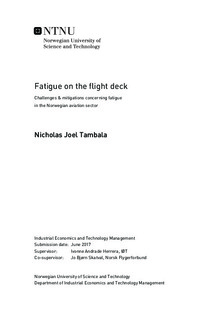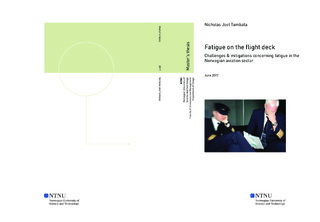| dc.description.abstract | The main objective of this master s thesis is to explore to what extent pilots in Norway are affected by fatigue whilst working. To understand the environment pilots are working under, gathering information from different stakeholders in the Norwegian aviation sector, is another important objective. The same can be said for measures for preventing or coping with fatigue. Fatigue is a known challenge within the aviation industry, but is still an issue where there may be ambiguities surrounding the contributing factors or contexts. A study of the work environment for flying personnel by the Norwegian Civil Aviation Authority (NCAA), found that only 19% of pilots and 12% of cabin crew in large fixed-wing (FX) airlines respond that they get sufficient amounts of rest and relaxation between workdays. Additionally, 72% of pilots and 85% of cabin crew feel physically exhausted after the completion of a work period.
In this thesis, a qualitative approach based on gathering and reviewing secondary quantitative and qualitative data on fatigue is used as a method. These findings are used to design the qualitative study; performing strategic interviews of pilots and managers in SAS, NAS/NAI and Widerøe, in addition to representatives from the NCAA. The strategic interviews are used as innovation process for gaining new experience, and a total of 13 individuals participated. The interview questionnaire that is designed, can be applied on a regular basis in future studies.
Conclusively, Norwegian pilots are experiencing varying degrees of fatigue. Some state that they are so tired they even fall asleep on the flight deck. Stakeholders from the Norwegian aviation sector perceive fatigue as a challenge that needs to be continuously worked with. Fatigue is experienced highly individually. What is also apparent is that there is a current under-reporting of fatigue in Norway. Both the NCAA and the airlines need more fatigue-reports to mitigate the issues that arise, whilst the personnel in the sharp end are asking for changes.
This thesis presents several measures that can be implemented by pilots, managers and the NCAA to mitigate fatigue. Currently, many of the respondents state that an improvement and exploration of options is necessary. More work is needed in trying different systems and mechanisms instead of merely adhering to the prescribed flight time limitations (FTLs) and flight duty periods (FDPs). In a broader perspective, I would say there is a need for more research on fatigue in the aviation sector. There are several important themes that need to be discussed in more detail on all the levels that are mentioned. There is a need for studies which show more specific issues regarding fatigue. These scientific results should also be used to a larger degree when making fatigue-related decisions. | |

